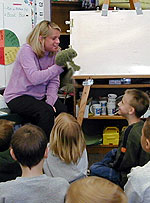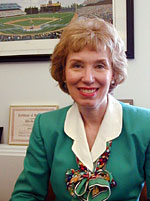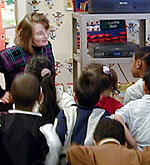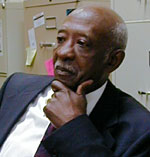By Tim Pugmire
Minnesota Public Radio
June 3, 2002
School district officials throughout Minnesota say a funding crisis is forcing them to redefine public school education. They've cut services, increased fees and laid off teachers to fix their budgets. Now they're looking for long-term financial solutions. While some educators push for more creative uses of school resources, others are pushing for a whole new system.
| |
|
|
|
||
The school year ended this week at Beaver Lake Elementary in Maplewood, and the first-grade students who recently listened to story time won't be coming back. Officials in the North St. Paul-Maplewood-Oakdale school district closed the small kindergarten through fifth grade school, and reassigned 400 students, as part of a $7 million budget fix. They asked local residents for additional tax support last fall, but a levy referendum failed by 160 votes.
"You see the children in tears," said teacher Kari Peterman. "And you see the children, it's just hard that they're going to be missing all their friends and going to new places they've never been and with new teachers. But you just hope that they'll be able to transition and make it. But it is going to be difficult."
Legislators changed Minnesota tax law last year to take most of the cost of public education off local property taxes. A record 181 school districts then asked local voters in November to put some of the expected savings back into their schools. They saw the referendums as a way to make up for a less-than-expected increase in state education funding. But voters in about a third of those districts weren't convinced of the need.
Rep. Alice Seagren, R-Bloomington, chairwoman of the House K-12 Education Finance Committee, says local school referendums provide voters a rare opportunity.
"School districts are the only governmental entity that has to go out to the taxpayer for a tax increase, or for an increase in revenues," Seagren said. "Cities and counties don't have to do that. So, I think it's also easy for the taxpayer to say 'no.' That's the only opportunity they have to say no to tax increases."
Seagren says that system is unfair, and several education groups agree. The Association of Metropolitan School Districts is pushing to change state law to allow school districts to levy local property taxes the same way cities and counties do now.
"We need to move away from a system where when we ask the question of whether or not we want to provide a quality education we need to go put it to a vote among the entire population, because that just does not make common sense," says Scott Croonquist, the association's executive director.
| |
|
|
|
||
With education funding expected to remain tight in the next state budget cycle, some lawmakers are looking at ways to help districts control costs. The price of health insurance, for example, has outpaced inflation, causing havoc in most school district's budgets.
Sen. Leroy Stumpf, DFL-Thief River Falls, chairman of the Senate K-12 Finance Committee, says legislation passed into law this year to develop a statewide health plan for school employees could eventually save millions.
"Last year our school districts spent $400 million, this year they spent $475 million, next year they're projected to spend $550 million on health insurance for school employees," Stumpf said. "One of the things we want to look at is can we somehow slow this health care cost increase down, even if we could stabilize it?" Stumpf says.
School district officials throughout Minnesota say they've tried to keep this year's budget cuts as far away from the classroom as possible. But some education leaders think there's waste and inefficiency lurking in classrooms too.
Christine Jax, commissioner of the Department of Children, Families and Learning, says districts have a history of adding instructional programs without regular evaluation.
"We hear about something that's good, we'll add it, whether it's a reading program, whether it's an intervention strategy, an after-school program, more staff," Jax said. "And we're not as apt to reallocate or decide what we don't need to do any further. And I think that's because we haven't necessarily had all of the research, we haven't had all the facts. I think we're moving closer to having all that so we can make informed decisions as to where the money is best spent and where we don't need to spend it any further."
| |
|
|
|
||
Jax and other policy makers are counting on a new fiscal analysis of Minnesota public schools to shine a bright light on ineffective spending. Legislation approved in 2001 requires the CFL to hire an independent contractor to evaluate the academic and financial performance of all schools. The first such report is at least a year away.
The education commissioner also supports Gov. Ventura's radical proposal for a large-scale consolidation of the state's 345 school districts. Jax says if Minnesota's 87 counties were also school districts, they could better address the social service needs of students.
"If our counties and our school districts share the same lines then there's less chance of duplication of effort and also less chance of children falling through the cracks," Jax said. "We'd have better collaboration and better communication, and that might be the way to make sure that the social service needs of students are met without burdening teachers."
Education organizations will continue to lobby for more money to improve schools. Other education reformers claim no amount will ever change the way traditional schools operate. Instead they want a new system, and more choices for families.
| |
|
|
|
||
Cedar Riverside Community School in Minneapolis opened in 1993 and is one of the state's oldest charter schools. Housed in modest office space, the school serves 105 students in kindergarten through eighth grade. Classes have fewer than 20 students. Charter schools are run by teachers and parents free of many state regulations. Teachers often earn less than in the traditional system, but they have a bigger say in the school's operation.
School director Shelton Rucker says charters are more efficient and effective than large public schools.
"Charter schools operate from the framework of whatever their goals are, and that's where they put their resources," Rucker said. "Because of the size, it's flexible enough if it's not occuring, if you're not meeting those goals, you can make some changes almost immediately."
There are 1,800 public schools in Minnesota. No one is suggesting a mass conversion to charter schools, but some school reformers are pushing to reorganize large public schools to have the look and feel of a charter school.
School leaders in Minneapolis and St. Paul are transforming their large high schools into small learning communities next fall. They say the reorganization will provide more personalized learning for all students.




